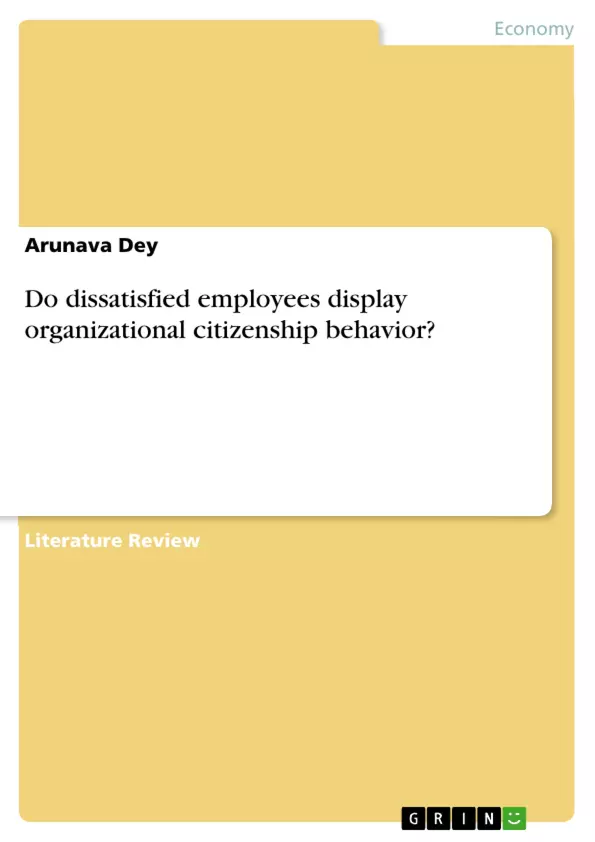This conceptual paper aims to explore whether dissatisfied non sales employees of life insurance industry in India would display Organizational Citizenship behavior. The paper investigates the moderating effect of Organizational Commitment on EVLN Model: Exit, voice, Loyalty and Neglect as a response to job dissatisfaction leading to OCB. The research pertaining to life insurance is scant. Further, previous studies have not examined whether or not dissatisfied non sales employees of life insurance industry would display OCB. The present study is an attempt to understand the same. If the organization identifies the dissatisfied employees and addresses their grievances then those employees responding to “Voice” and “Loyalty” option of EVLN Model would not only be retained with the organization but also are likely to display OCB. OCB enhances positive vibe, cohesiveness and bonding among the team members in the work place resulting into diminished conflicts and enhanced productivity.
Table of Contents
- Introduction
- Methodology
- Literature Review
- Part 1: The OCB Construct
- Part 2: EVLN Model: The Construct
- Part 3: Organizational Commitment
Objectives and Key Themes
This conceptual paper explores whether dissatisfied non-sales employees in the Indian life insurance industry display Organizational Citizenship Behavior (OCB). It investigates the moderating effect of Organizational Commitment on the EVLN Model (Exit, Voice, Loyalty, and Neglect) as a response to job dissatisfaction leading to OCB. The study examines the potential for organizations to identify and address the grievances of dissatisfied employees, leading to increased retention and OCB, ultimately promoting a positive work environment and enhanced productivity.
- Organizational Citizenship Behavior (OCB) in the context of job dissatisfaction
- The moderating effect of Organizational Commitment on employee responses to job dissatisfaction
- The EVLN Model as a framework for understanding employee responses to job dissatisfaction
- The impact of OCB on workplace dynamics and organizational performance
- Exploring the specific challenges faced by non-sales employees in the Indian life insurance industry
Chapter Summaries
- Introduction: This chapter introduces the concept of insurance and defines the target population for the study – non-sales employees in the Indian life insurance industry. It highlights the challenges of defining and evaluating job roles for these employees, particularly in relation to performance appraisal. The chapter concludes by outlining the study's objective, which is to explore whether dissatisfied non-sales employees display OCB.
- Methodology: This chapter details the research methodology, including the data collection process from 25 journals to understand the constructs of OCB, the EVLN model, and Organizational Commitment. It also outlines the formulation of eight hypotheses.
- Literature Review: This section comprises three parts, each focusing on a key concept:
- Part 1: The OCB Construct: This part explores the historical development of the OCB concept, defining it as discretionary behavior that promotes organizational effectiveness. It discusses various classifications of OCB behaviors and highlights the five key dimensions identified by Organ (1988) – altruism, conscientiousness, sportsmanship, courtesy, and civic virtue.
- Part 2: EVLN Model: The Construct: This part examines the EVLN Model, which describes four responses to job dissatisfaction: Exit, Voice, Loyalty, and Neglect. The chapter discusses the history of the model, exploring the contributions of Hirschman (1970) and Rusbult et al (1982). It also highlights the potential benefits and drawbacks of each response for organizations.
- Part 3: Organizational Commitment: This part defines organizational commitment as the extent to which employees identify with an organization's goals. It explores different perspectives on the concept, including its significance for organizational success. The chapter concludes by discussing the three components of organizational commitment: affective, continuance, and normative commitment.
Keywords
This conceptual paper focuses on the relationship between job dissatisfaction, Organizational Citizenship Behavior (OCB), Organizational Commitment, and the EVLN Model (Exit, Voice, Loyalty, and Neglect). It specifically examines these constructs within the context of non-sales employees in the Indian life insurance industry. The key themes explored include employee behavior, workplace dynamics, performance appraisal, and organizational effectiveness.
- Arbeit zitieren
- Arunava Dey (Autor:in), 2018, Do dissatisfied employees display organizational citizenship behavior?, München, GRIN Verlag, https://www.grin.com/document/493792



